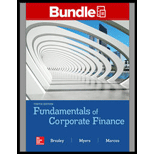
a.
To discuss: Whether the given statement is classified under true of false.
a.
Answer to Problem 1QP
The given statement is classified as“False”.
Explanation of Solution
The reasons supporting the statement to be false is as follows:
Generally, the bid price is consistently lower comparative with the ask price, which results in the bid-ask spread.
Therefore, the given statement is classified as “False”.
b.
To discuss: Whether the given statement is classified under true of false.
b.
Answer to Problem 1QP
The given statement is classified as “False”.
Explanation of Solution
The reasons supporting the statement to be false is as follows:
The investor who want to sell quickly at the best accessible price would enter a market order.
Therefore, the given statement is classified as “False”.
c.
To discuss: Whether the given statement is classified under true of false.
c.
Answer to Problem 1QP
The given statement is classified as “False”.
Explanation of Solution
The reasons supporting the statement to be false is as follows:
Sales by and between investors happen in the secondary market. Primary offerings are said to arise in the primary market and are sold by the company which issues it.
Therefore, the given statement is classified as “False”.
d.
To discuss: Whether the given statement is classified under true of false.
d.
Answer to Problem 1QP
The given statement is classified as “False”.
Explanation of Solution
The reasons supporting the statement to be false is as follows:
ECNs are computer related systems that organizes and links different merchants with one another.
Therefore, the given statement is classified as “False”.
Want to see more full solutions like this?
Chapter 7 Solutions
FUNDAMENTALS OF CORP.FIN.(LL)-W/CONNECT
- Explain how an increase in interest rates by a central bank could affect bond prices and stock market performance.arrow_forwardWhat is the purpose of diversification in an investment portfolio, and how does it reduce risk? Need help!arrow_forwardWhat are the key differences between a company’s income statement and its cash flow statement? Why are both important for financial analysis? Need help!arrow_forward
- What are the key differences between a company’s income statement and its cash flow statement? Why are both important for financial analysis?arrow_forwardWhat is the relationship between risk and return in finance, and how is this reflected in the Capital Asset Pricing Model (CAPM)? Explain.arrow_forwardDefine the time value of money (TVM). How does TVM influence decision-making in capital budgeting? Explanation.arrow_forward
- What is the relationship between risk and return in finance, and how is this reflected in the Capital Asset Pricing Model (CAPM)?arrow_forward3. Explain the concept of compounding. How does compounding impact the future value of an investment? Need help!arrow_forward3. Explain the concept of compounding. How does compounding impact the future value of an investment?arrow_forward
- What is the difference between a stock and a bond, and how do they function as investment options? Need help now !arrow_forwardWhat is the difference between a stock and a bond, and how do they function as investment options? Rxplarrow_forwardWhat does the internal rate of return (IRR) tell you about a potential investment? Rxarrow_forward
 Essentials Of InvestmentsFinanceISBN:9781260013924Author:Bodie, Zvi, Kane, Alex, MARCUS, Alan J.Publisher:Mcgraw-hill Education,
Essentials Of InvestmentsFinanceISBN:9781260013924Author:Bodie, Zvi, Kane, Alex, MARCUS, Alan J.Publisher:Mcgraw-hill Education,

 Foundations Of FinanceFinanceISBN:9780134897264Author:KEOWN, Arthur J., Martin, John D., PETTY, J. WilliamPublisher:Pearson,
Foundations Of FinanceFinanceISBN:9780134897264Author:KEOWN, Arthur J., Martin, John D., PETTY, J. WilliamPublisher:Pearson, Fundamentals of Financial Management (MindTap Cou...FinanceISBN:9781337395250Author:Eugene F. Brigham, Joel F. HoustonPublisher:Cengage Learning
Fundamentals of Financial Management (MindTap Cou...FinanceISBN:9781337395250Author:Eugene F. Brigham, Joel F. HoustonPublisher:Cengage Learning Corporate Finance (The Mcgraw-hill/Irwin Series i...FinanceISBN:9780077861759Author:Stephen A. Ross Franco Modigliani Professor of Financial Economics Professor, Randolph W Westerfield Robert R. Dockson Deans Chair in Bus. Admin., Jeffrey Jaffe, Bradford D Jordan ProfessorPublisher:McGraw-Hill Education
Corporate Finance (The Mcgraw-hill/Irwin Series i...FinanceISBN:9780077861759Author:Stephen A. Ross Franco Modigliani Professor of Financial Economics Professor, Randolph W Westerfield Robert R. Dockson Deans Chair in Bus. Admin., Jeffrey Jaffe, Bradford D Jordan ProfessorPublisher:McGraw-Hill Education





